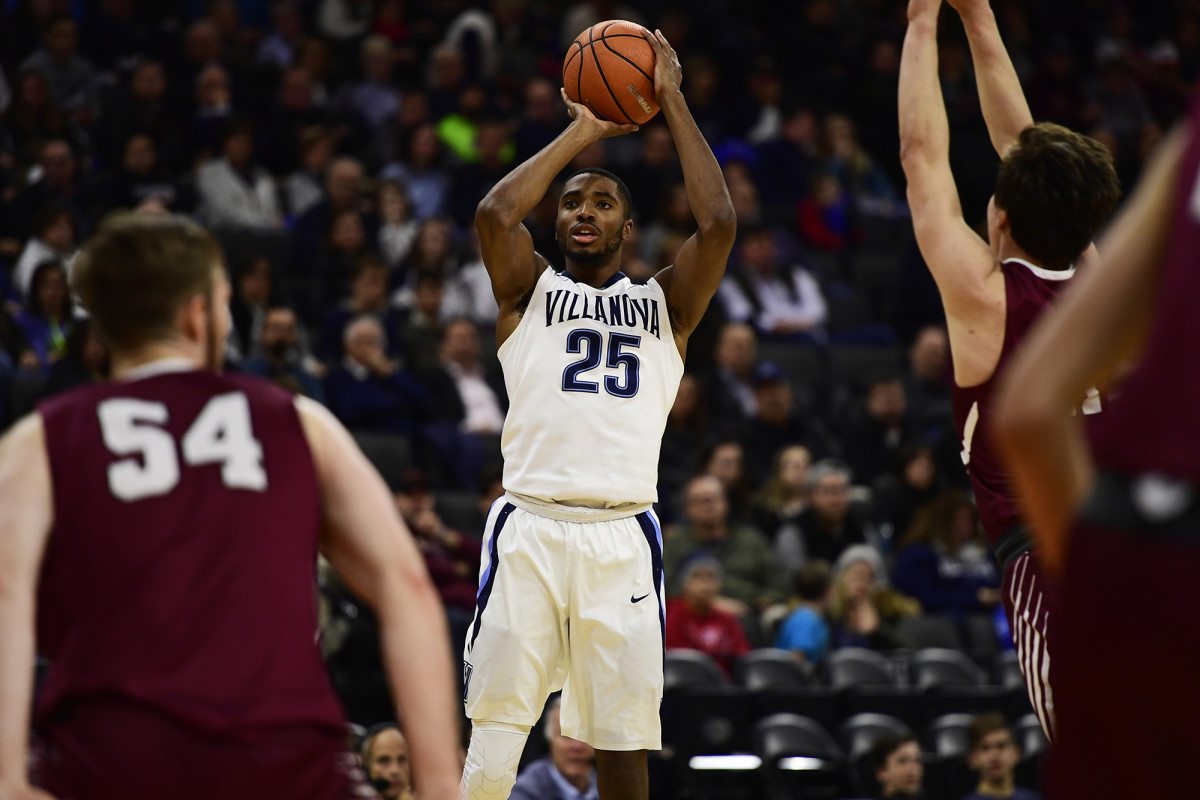How Mikal Bridges Transformed into Villanova's Star Leader and a Potential Lottery Pick

There’s a limit to what you can learn from Wikipedia, and especially from its photographs. The images are typically royalty-free and user-provided, resulting in a number of athletes being depicted in blurry, pixelated portraits snapped on a fan’s cell phone from Section 207. But in the case of Villanova forward Mikal Bridges—whose entry on the site features not one but two action shots from last February, both uploaded by a user named TonyTheTiger—an unfamiliar skimmer could at least glean one important aspect of his game: the long, lean frame that makes him such an unwieldy presence for opponents. In the top photo he is shown mid-dribble, waist bent and left shoulder dipped with the ball so that it looks like he can easily scratch his shin; below that he is viewed in profile with every limb bent, his Slender Man-lank half-coiled like a spider at rest. Neither shows him at maximum extension, deploying his body at its fullest.
What you can learn from watching Villanova play this year is that the 6’7” Bridges has spread his 7-foot wingspan to become one of the country’s breakout stars, on what is now its No. 1-ranked team. Through 10 games the junior has averaged 18.1 points and 6.4 rebounds while making 48.1% of his threes, of which he takes 5.4 per game, all while defending all five positions on the floor and spearheading the three-quarter press for the nation’s seventh-stingiest defense. His efficiency (51st nationally) in a high-usage is such that Kenpom.com currently has Bridges ranked third in its national player of the year rankings, but what is perhaps most surprising is that his efficiency numbers and rate stats were nearly identical last season, albeit in a complementary, lower-usage role. In a sense, he is playing like a new star who has been here all along, waiting to unfurl himself more completely.
Doing so has been a gradual process, and it begins with that same long frame. Four years ago Bridges arrived on campus just 17 years old—with an Aug. 30 birthday he’d always been young for his grade—and 175 pounds, so thin that the coaching staff feared his body might not be able to withstand a college season’s rigors. He had shone during individual summer workouts, but when the Wildcats began practicing in full that fall, Bridges says, “I was hurting all the time, battling all the seniors.” Head coach Jay Wright came to Bridges with a proposal: sit out the season as a redshirt, bulk up, and take the floor the next year more capable of withstanding the physicality. Says Quinnipiac head coach Baker Dunleavy, a Villanova assistant at the time: “It was just using our imagination and convincing him, ‘This isn’t a redshirt because you’re not ready; it’s a redshirt to explore what you can be.’”
Thus began a regimen that included four weekly lifting sessions—double his teammates’ in-season routine—with Villanova strength and conditioning coach John Shackleton, supplemented by heaps of grilled chicken and baked potatoes. By the end of the season he was up to 207 pounds (he’s currently listed at 210), and by February he had grown to more regularly hold his own in practice. Another transformation took place with Bridges’s jumpshot, which began on the left side of his body and had to be refashioned with his right elbow under the ball, in front of his body, drilled into muscle memory over “easily over, like, multiple hundreds” of shots everyday, Bridges recalls. His coaches believed Bridges could be a shooter, if only his form were rebuilt to one that would work on the college level.
“I was a shooter in high school,” Bridges says now, saying it was his form, not his accuracy, that needed work. “That’s what I was known for.” What he was not, at least at first, was much of a prospect. Bridges stood a relatively modest and wiry 6’3” in his sophomore season at Great Valley High in Malvern, Pa., a program that had not previously produced a Division I player. When his coach, Jim Nolan, phoned D-I coaches to alert them to the eventual top-100 recruit, Nolan was patronized at best, ignored at worst.

“I remember one guy saying, ‘Oh, we get these calls all the time,’” says Nolan. Some ACC and Atlantic 10 coaches didn’t respond at all. Then Bridges grew four inches and emerged as the Patriots’ most desirable player. “When the spring came, they called,” Nolan says. “And I turned around and said, ‘I told you.’ By then he already had like 20 offers.”
Bridges’s role on Nolan’s teams will be familiar to those who have watched him at Villanova: he played and defended all five positions, and he scored efficiently and effectively without dominating the ball or being leaned on to generate points in isolation. Nolan runs a passing, cutting, Princeton-esque offense that emphasizes movement away from the ball, and when Dunleavy and then fellow Wildcats assistant Billy Lange (now on the 76ers’ staff) saw Bridges operate within it, they became enamored. “He wasn’t dominant, but you just saw an innate IQ,” Dunleavy recalls. “We were so intrigued. We kind of fell in love with the idea of what he could be.”
When he arrived on campus, Bridges’s experience as a cog within an equal-opportunity system paid immediate dividends. “Some stars come into college and they don’t know how to play with all these good players,” Wright says. “But he fit in right away.” As a redshirt freshman the Wildcats’ 2015-16 national title team, Bridges served as a seventh-man glue guy providing defense and a little bit of everything else, including a loose-ball dive to secure their trip to the Final Four and a homerun dunk once they got there. Last season he took over a starting role, but deferred shots to seniors Josh Hart and Kris Jenkins, his usage rate so low—15.4% of Villanova’s possessions when on the floor, and 16.1% of its shots—that Kenpom.com classified him in the roster’s fourth tier, for this with “limited roles.” “When we needed him, he was there,” Wright says. “If we didn’t, he was fine.”
This year, it’s clear the Wildcats need Bridges in order to be the elite team they have been so far. In last season’s complementary role, Bridges was impressively efficient, ranking 22nd nationally in KenPom.com’s offensive rating and in the country’s 98th percentile according to Synergy Sports. This year, despite his usage ballooning to from 15.4% of Villanova’s possessions to 21.8%, and his share of shots from 16.1% to 24.7%, he has produced at nearly the same rate on a per-possession basis, ranking 51st nationally on Kenpom.com and again in the 98th percentile via Synergy. His three-point shooting has sharpened further from 39.3% to 48.1%, and he remains a deflect-and-dash nightmare at the top of the Wildcats’ three-quarter press, ranking in the 92nd percentile in transition offense, with 1.686 points per possession. On Bridges heading that press, long a role of importance in “igniting” Villanova teams, Wright says he’s “become the best ever at that.” Just as important is his ability to slip into the post in the half court, bringing a flexibility to the Wildcats’ seventh-ranked defense.
There are new wrinkles too. Last season, Synergy did not log a single post-up possession for Bridges; this year he has 13 such possessions, on which he’s scored 19 points, making him the eighth-most efficient post-up player in the country, albeit in a small sample. His spot-up scoring has increased from 1.052 points per possession to 1.429, putting him in the top five percent overall. His recalibrated jumper now earns him 1.236 points per try, good for the 85th percentile and a .164 increase over last season.
“The thing Coach tells me is just play off your jumpshot and everything else will come,” Bridges says. “I feel like I can do anything after I start making the shot.”
Duke's Defense and Other Areas Where Top Teams Need to Hit the Books
Like Dunleavy and Lange before them, NBA scouts are now intrigued by what Bridges can be as well. He has risen to 10th in SI’s latest Big Board, reflecting his potential as a rangy three-and-D wing capable of an impact beyond such a role. (His 10-second dunk-and-block combo against Gonzaga last week, perhaps the end-to-end sequence of the season, may have given his earning potential a seven-figure boost.) Where Bridges’s body and skillset once offered potential, his aggression and flourishing in a go-to role suggest promise he may deliver on it. “Any doubt that he’s the best player on the floor every time has been erased,” Dunleavy says. “He just knows it, and it allows him to play with an incredible confidence. It frees up his mind to be a great player.”
Bridges deflects any talk of what his future may hold—he will have a year of college eligibility remaining after this one—but Wright has been unable to avoid it, thanks to another once-skinny Wildcat: Kerry Kittles, who Wright recruited as a Villanova assistant under Rollie Massimino and who later averaged 14.1 points over eight NBA seasons. Kittles has become a sort of mentor to Bridges, who calls Kittles his “big bro,” and after Bridges’s showcase against Gonzaga he texted Wright to tell him he might have an even brighter star on his hands. “Kerry says he’s gonna be better than he was,” Wright says. “I even argue with Kerry about that. But I’d love to see him do it.”
Lofty praise, sure. But as Bridges’s game continues to unfold, it’s hard to imagine much of anything beyond his reach.
